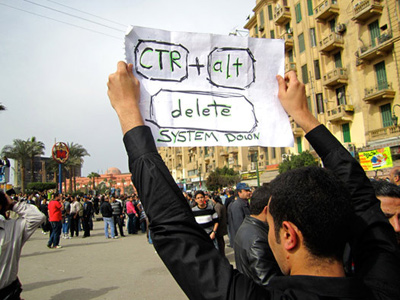Tahrir Square: Social Media, Public Space
A few months ago I moved from Brooklyn back to Cairo for what I anticipated would be a quiet year of research on my dissertation. My topic is mid-20th-century architecture and urban planning in Egypt; my focus is the 1952 coup d’état that swept away the monarchy of King Farouk, and the period of pan-Arab socialism that followed under the presidency of Gamal Abdel Nasser — a period during which the new republic deployed a modernist, international style design for state building projects.
I’ve been living in Garden City, a leafy neighborhood on the eastern bank of the Nile, just a short walk from Tahrir Square. Almost daily I walked to Tahrir to catch a bus for the hour-long ride to the new suburban campus of the American University. My routine was not unusual. Tahrir Square is part of daily life for many people: it’s a major downtown square surrounded by important government headquarters and major cultural institutions, and it’s a busy crossroads jammed with honking cars and buses. For tourists Tahrir is the locale of the famed Egyptian Museum; for some Cairenes it is the destination for official state business, for many others it is one of the over-congested places of downtown Cairo to be avoided. For me — even before the latest revolution — Tahrir Square had come to symbolize the failure of the urban planning policies carried out during the three-decade rule of Hosni Mubarak.
The Mubarak government extended a series of policies initiated under Anwar Sadat. The regime supported laws and actions that sharply limited Egyptians’ access to public space — to places where citizens could congregate, meet, talk, interact. It promoted the development of gated communities with private parks, golf courses and luxury shopping malls, and in doing so facilitated the exodus of Cairo’s middle and upper classes into the desert at the city’s periphery. At the same time the government ignored the city’s center; its ongoing mismanagement of housing development has resulted in the extensive zone of informal housing, mostly unfinished brick shanties, that rings Cairo. And Mubarak worked to effectively dismantle and depopulate Cairo’s much-admired public squares and parks, including not just Tahrir Square but also Ramses Square and Azbakiyya Gardens. For decades, in fact, public policy and urban planning, like most governmental matters, were filtered through the harsh lens of state security.
Urban open spaces — anywhere citizens might congregate and stage political demonstrations — were systematically subdivided or fenced off or given over to vehicular traffic and flyovers, and thus made challenging and even scary for pedestrians. Collectively such policies have led not only to the decline of public space but also to the inexorable deterioration of cities and the erosion of civic pride.
The January 25th Revolution has had a dramatic, immediate effect on how Egyptians occupy Cairo and interact with one another. Commentators in the West have been quick to credit online social networking with empowering the protests. But the revolution that started in January 2011 in Cairo has provided powerful evidence that the virtual is not enough: in the course of several historic days in Tahrir Square it became decisively clear that the occupation of physical urban space was, and continues to be, crucial to the success and continuity of the revolution. No doubt the initial rush of online exhortations, including the Jan. 25 call to protest police brutality, was vitally important; but as we now know, the country was unplugged for six days, from Jan. 28 through Feb. 5, during which period the protests actually grew larger and the protestors became even more determined not merely to express popular dissent but ultimately to overthrow the regime.
Continue reading: Design Observer
Text and images by Mohamed Elshahed, February 2011
Tahrir Square: Social Media, Public Space
RELATED WEB SITE
→ author`s blog
[ Arab Army ]
[ Coincidental Destinies ]
[ MODERN LEAVES ]
[ Moving on – Moving back – Moving on ]
[ On images, voices and information – a media approach to the Egyptian revolution ]
[ Setting ]
• Tahrir Square: Social Media, Public Space •
[ Tank Man Tango ]
[ War Tourist ]
FEATURED THEME ON CITY SHARING
by ASUNCION MOLINOS GORDO
-
This project is an instrument for common critical analysis to help understand the reasons behind Egyptians’ diminishing …
by INAS HALABI
-
The project Letters to Fritz and Paul focuses on the expeditions of the Swiss cousins, lovers and scientists, Fritz and …
by SARAH BURGER
-
The planned modern city of Brasilia attracted me since a long time. Her defined shape, location and function proceded he …
by ADRIEN GUILLET
-
Youri Telliug talks with the artist Adrien Guillet about his project Citracit
Youri Telliug - What is Citracit …
by NIGIST GOYTOM
-
In 2013 more than 45 million people have been forced to leave their homes. This amounts to the biggest number of refugees …
by SULAFA HIJAZI
-
The on going debate on Arab identity and its (cultural) representation is strongly shaped by Edward Saidʼs formative …
by ASUNCION MOLINOS GORDO
-
WAM is a site-specific work that uses the historical trope of the cabinet of curiosities to explore the introduction of …
MORE CONTRIBUTIONS BY THE FOLLOWING
